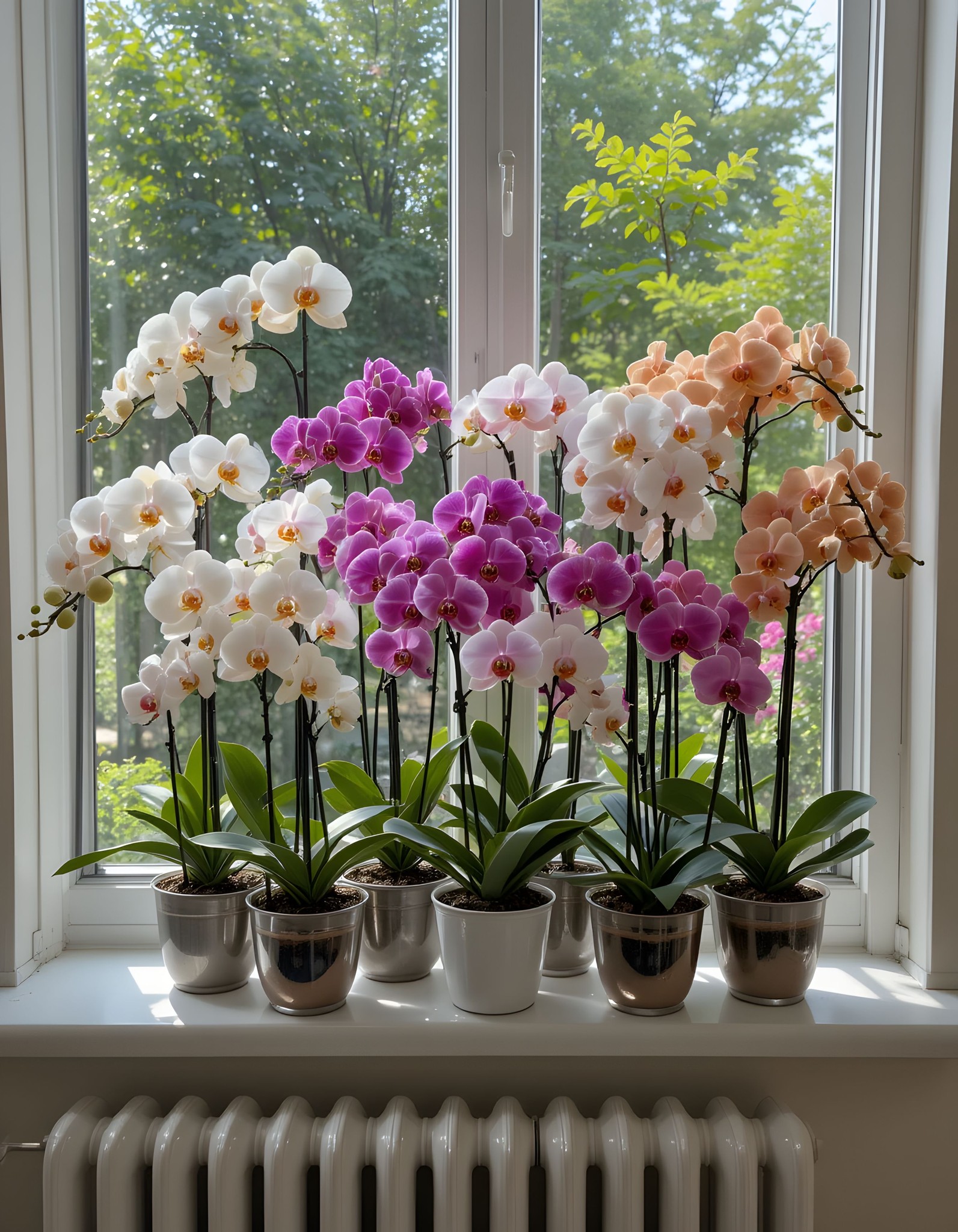Phalaenopsis orchids, commonly known as Moth Orchids, are one of the most popular and stunning types of orchids that bring elegance and beauty to any space. With their intricate, long-lasting blooms and exotic appearance, Phalaenopsis orchids are perfect for both beginners and experienced gardeners. However, these beautiful plants require specific care to thrive and bloom year after year. If you’re ready to nurture your Phalaenopsis orchid, here’s everything you need to know about how to care for it, from lighting to repotting.
✨ Why Choose Phalaenopsis Orchids? ✨
Phalaenopsis orchids are popular for their ability to adapt well to indoor environments, their resilience, and their relatively easy care compared to other types of orchids. With their striking, delicate flowers that bloom in various colors, Phalaenopsis orchids are perfect for adding a splash of color to your home or office. Plus, their long-lasting blooms can stay vibrant for weeks, making them an excellent choice for those who love low-maintenance, show-stopping plants.
🏡 Essential Care Conditions for Phalaenopsis Orchids 🏡
To help your Phalaenopsis orchid flourish, you need to create the ideal conditions for it to grow. Let’s break down the key care conditions that these orchids need.
💡 Light: The Perfect Balance of Bright, Indirect Light
Phalaenopsis orchids prefer bright, indirect light, but be cautious about direct sunlight, as it can scorch the delicate leaves. Too much sunlight can cause the plant’s leaves to become yellow or brown, while insufficient light will inhibit blooming.
Ideal Lighting Locations:
East- or West-facing windows are the best spots, as they receive light that is gentle yet adequate for your orchid.
If your orchid is near a south-facing window, try to filter the light with sheer curtains to prevent sunburn.
A grow light can also be used if natural light is insufficient.
🌡️ Temperature: A Comfortable Range of Warmth
Phalaenopsis orchids thrive in a warm environment. They prefer a daytime temperature range of 65-80°F (18-27°C).
Night Temperature:
Phalaenopsis orchids enjoy cooler temperatures at night, usually 5-10°F cooler than daytime temperatures.
A temperature range of 55-65°F (13-18°C) at night is ideal.
Avoid placing your orchid near drafts, cold windows, or heat sources such as radiators, as temperature fluctuations can stress the plant and affect blooming.
💧 Humidity: Creating the Right Moisture Levels
Phalaenopsis orchids love moderate to high humidity, ideally between 50-70%. The dry air in many homes, especially during winter, can be challenging for these plants. To ensure your orchid thrives:
Increase Humidity by:
Using a humidifier: This is the most effective way to maintain the right humidity levels.
Placing the pot on a humidity tray: Set your orchid on a tray filled with pebbles and water (without the pot sitting in the water). This increases the surrounding humidity.
Misting occasionally: Lightly misting the leaves once or twice a day can also boost humidity, but be careful not to overdo it.
🌱 Watering: The Key to Healthy Roots
Overwatering is one of the most common causes of orchid problems, so it’s crucial to follow a proper watering routine. Phalaenopsis orchids like to be watered thoroughly when the potting medium is almost dry, but they do not like sitting in stagnant water.
Watering Tips:
Water thoroughly: Water until the water drains out of the bottom of the pot, ensuring the roots get hydrated.
Check the potting medium: If the top inch or so of the soil is dry, it’s time to water. However, if it still feels moist, wait before watering again.
Avoid overwatering: Let the potting mix dry out between waterings to prevent root rot. The orchid roots should never sit in water for too long.
🌿 Potting Medium: The Best Mix for Orchids
A well-draining potting mix is essential for Phalaenopsis orchids. Unlike traditional houseplants, orchids do not grow in regular soil. They prefer a mixture that allows air to reach the roots while also holding moisture.
Ideal Orchid Potting Mix:
Bark: Provides structure and allows water to drain freely.
Sphagnum moss: Helps retain moisture and adds nutrients.
Perlite: Improves aeration and drainage.
Charcoal: Helps keep the medium fresh and prevents odors.
Repotting your Phalaenopsis orchid in fresh, well-draining orchid mix every 2-3 years is a good way to ensure it has the proper environment for growth.
🌱 Fertilizing: Boosting Growth and Blooms
Orchids need proper nutrition to thrive and bloom. A balanced orchid fertilizer is the best way to ensure your Phalaenopsis gets the nutrients it needs.
Fertilizing Tips:
Use a balanced orchid fertilizer diluted to half strength every 2-4 weeks during the growing season (spring and summer).
Reduce fertilizing during the plant’s dormant period, usually in winter, to prevent nutrient overload.
Apply fertilizer when the soil is moist, as this helps prevent any potential fertilizer burn on the roots.
🌿 Repotting: Keep Your Orchid Comfortable
Phalaenopsis orchids should only be repotted when necessary, about every 2-3 years. Over time, the potting mix will break down, and the orchid may outgrow its pot. Repotting is an opportunity to refresh the growing medium and provide extra space for the roots.
When to Repot:
If the roots are outgrowing the pot or the medium has broken down.
If the orchid is not blooming or growing as well as it used to.
Repotting Steps:
Choose a pot that is slightly larger than the current one.
Remove the old potting medium and inspect the roots. Trim any dead or rotting roots.
Place the orchid in the new pot, filling around the roots with fresh orchid mix.
Water lightly after repotting to help settle the soil.
🌟 Additional Tips for Phalaenopsis Orchid Care
Encourage reblooming: After your orchid finishes blooming, cut the flower spike back to just above the node where the first bloom appeared. In some cases, this will encourage the orchid to bloom again.
Prevent pests: Keep an eye out for common orchid pests such as aphids, mealybugs, and scale. Wipe the leaves gently with a damp cloth and remove any pests you spot.
Prune dead flowers: Once the flowers fade, cut the flower spike back to encourage new growth and blooms.
🏡 Conclusion: Bringing Beauty to Your Home with Phalaenopsis Orchids
With their beautiful flowers and graceful presence, Phalaenopsis orchids are a wonderful addition to any home or garden. By following these care tips—providing the right light, temperature, humidity, and watering practices—you’ll be able to enjoy their stunning blooms for years to come. Whether you’re a seasoned gardener or just starting out, caring for these plants can be a rewarding and fulfilling experience.
Let your Phalaenopsis orchid brighten up your home and bring a little piece of nature indoors! 🌺🥀🌷
More Articles You Might Like
-
Texas Toast Sloppy Joes: The Crunchy, Cheesy Upgrade You Didn’t Know You Needed
There’s something timeless about sloppy joes. For generations, this saucy, savory, and slightly sweet ground beef sandwich has been a go-to comfort food in American kitchens. It’s quick, filling, and family-friendly—perfect for busy weeknights. But what if we told you there’s a way to take this classic dish up a notch? Enter the Texas Toast…
-
Classic Pig Pickin’ Cake
When it comes to Southern desserts, few sweets shine as brightly as the Classic Pig Pickin’ Cake. This nostalgic cake, sometimes called a “Mandarin Orange Cake,” has roots deep in Southern tradition. It gets its playful name from its frequent appearance at pig pickin’s—Southern-style barbecue gatherings where communities come together to enjoy slow-cooked pork, sides,…
-
Lemon Garlic Butter Chicken with Creamy Parmesan Pasta
There’s something irresistible about the combination of tender, golden-browned chicken paired with a creamy pasta coated in Parmesan cheese. Add the brightness of lemon, the depth of garlic, and the richness of butter, and you have a recipe that feels indulgent yet approachable enough for a weeknight dinner. Lemon Garlic Butter Chicken with Creamy Parmesan…



